Text

Unlock the secrets to sky-high customer satisfaction! Dive into our guide on how Field Service Management Software transforms your service delivery, ensuring timely responses, seamless appointments, and impeccable after-service support. Elevate your brand's reputation and delight every client. Don't miss out!
#cmms#cmms software#Field Service Management#Field Service Management Software#Field Service Software#FSM Software#FSM
0 notes
Text
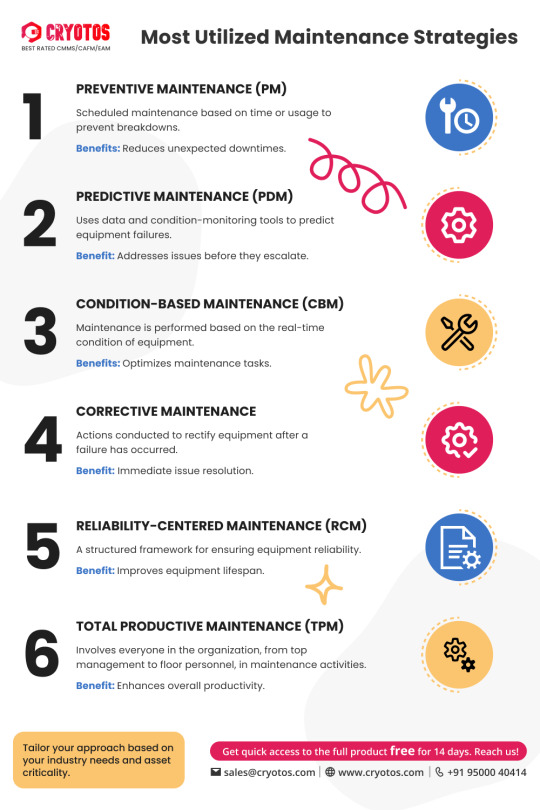
What are the Most Utilized Maintenance Strategies?
Unveiling the secrets to machinery longevity and optimal performance! Dive into our latest infographic on the 'Most Utilized Maintenance Strategies' and discover the key approaches that top industries swear by. Equip yourself with the knowledge to enhance efficiency and reduce costs. Now, with Cryotos Maintenance Management Software, you can harness the power of the most utilized maintenance strategies right at your fingertips.
#cmms#cmms software#maintenance management#maintenance software#preventive maintenance#predictive maintenance#facility management software#work order
0 notes
Text
Why Does A Manufacturing Industry Require Asset Management Software?
Manufacturing industries are complex ecosystems with numerous assets, from machinery to human resources. Asset management software streamlines the tracking, utilization, and maintenance of these assets. By providing real-time insights into asset performance, lifespan, and potential issues, such software ensures optimal productivity, reduces operational costs, and minimizes unplanned downtimes. In an era where efficiency and timely delivery are crucial, asset management software becomes an indispensable tool for manufacturing industries, ensuring they operate at peak performance and remain competitive in the global market.
#cmms#cmms software#maintenance management#maintenance software#predictive maintenance#preventive maintenance#facility management software#work order
0 notes
Text

8 Ways to Overcome the Maintenance Backlog with Cryotos CMMS
Managing a maintenance backlog is a common challenge for businesses, impacting efficiency and productivity. Discover effective strategies to tackle maintenance backlogs with Cryotos CMMS software. From prioritizing tasks to streamlining workflows, this article outlines eight practical ways to overcome backlogs and ensure your operations run smoothly. Explore how Cryotos CMMS empowers you to proactively manage maintenance tasks, optimize resource allocation, and enhance equipment reliability, all while maximizing the potential of your workforce. Take control of your maintenance backlog and boost your organization's performance with Cryotos CMMS.
#cmms#cmms software#maintenance management#maintenance software#preventive maintenance#predictive maintenance#facility management software#work order
0 notes
Text
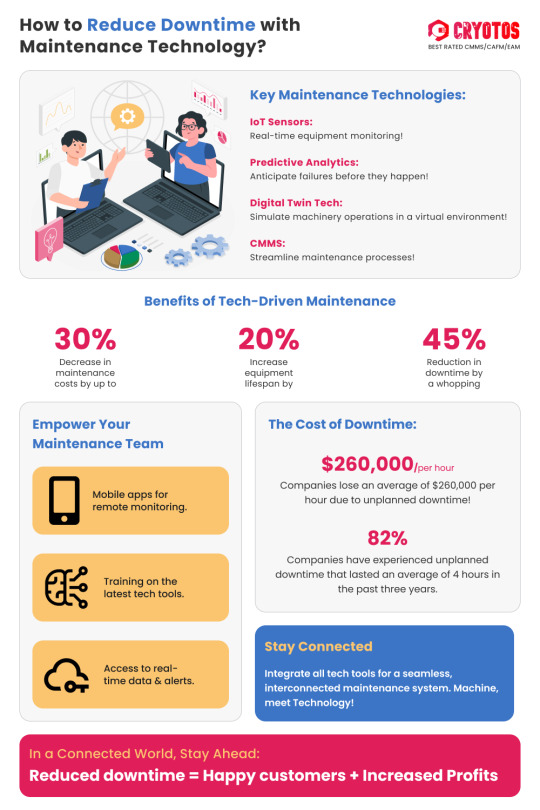
How to Reduce Downtime with Maintenance Technology?
Learn how to minimize costly downtime and boost operational efficiency with cutting-edge maintenance technology. Discover the benefits of predictive maintenance, real-time monitoring, and data-driven insights in ensuring your assets are always in top condition. Uncover the strategies to proactively address maintenance needs and prevent unexpected breakdowns, ultimately maximizing productivity and driving business growth. Say goodbye to unplanned downtime and embrace the power of modern maintenance solutions for a smoother, more reliable operation.
#cmms#cmms software#maintenance management#preventive maintenance#maintenance software#predictive maintenance#facility management software#work order#downtime
0 notes
Text
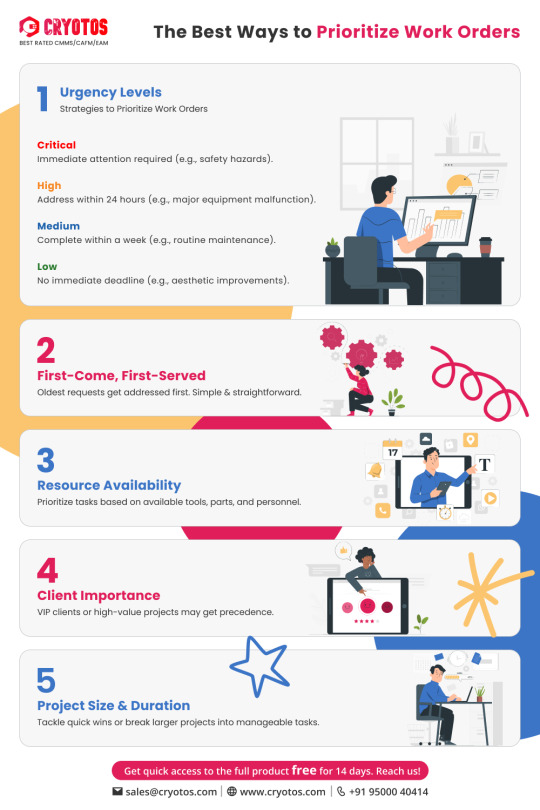
The Best Ways to Prioritize Work Order
Delving into the intricacies of work order management, this guide sheds light on the most efficient ways to prioritize tasks. From understanding the urgency and impact of each task to leveraging technology for streamlined scheduling, we explore strategies that ensure timely completion. By prioritizing work orders effectively, organizations can optimize resource allocation, reduce downtime, and drive enhanced operational efficiency, ensuring that the most critical tasks are addressed promptly without compromising on the quality of service.
#preventive maintenance#predictive maintenance#facility management software#maintenance software#maintenance management#cmms software#cmms#work order
0 notes
Text
Key Technology Trends in Facility Management 2023

The Evolution of Facility Management Technology
Facility management has evolved significantly, with technology playing a crucial role in driving these advancements. In the past, facility management relied heavily on manual processes and paper-based systems, leading to inefficiencies and challenges in managing complex facilities. However, with the rise of technology, facility management has undergone a transformative shift, paving the way for more efficient and data-driven operations.
In this blog, we will delve into the key technology trends that are set to reshape facility management in 2023. These trends encompass a wide range of innovations, from the integration of the Internet of Things (IoT) and smart building solutions to the utilization of artificial intelligence (AI) and augmented reality (AR) in facility maintenance and planning. We will explore how these technologies can enhance facility management efficiency, sustainability, and safety.
I. IoT and Smart Building Integration
A. Advancements in IoT for Facility Management
The Internet of Things (IoT) has emerged as a game-changer in facility management. IoT devices and sensors are embedded in various building systems, enabling real-time data collection and analysis. Facility managers can access critical information, such as temperature, humidity, occupancy, and energy consumption, remotely and in real-time. This data-driven approach empowers facility managers to optimize energy usage, predict equipment failures, and enhance overall operational efficiency.
B. Smart Building Solutions for Enhanced Efficiency
Smart building technology takes IoT integration a step further by creating an interconnected ecosystem of building systems. Energy management and sustainability are at the core of smart building solutions. Building managers can optimize energy consumption based on occupancy patterns and external environmental factors through smart sensors and automated controls. Moreover, smart building solutions offer insights into space utilization, enabling efficient space planning and allocation.
III. Artificial Intelligence (AI) in Facility Management
A. AI-driven Predictive Maintenance
Artificial intelligence (AI) is revolutionizing facility maintenance practices. Facility managers can adopt a predictive maintenance approach by harnessing the power of machine learning algorithms. AI analyzes historical data and equipment performance to predict potential equipment failures. This proactive approach enables facility managers to schedule maintenance activities before issues escalate, minimizing downtime and optimizing asset reliability.
B. AI-powered Energy Management
AI is also instrumental in optimizing energy management in facilities. AI-powered algorithms analyze real-time energy consumption data and identify opportunities for energy efficiency. Facility managers can receive actionable insights to adjust energy usage, reduce wastage, and lower operational costs.
IV. Augmented Reality (AR) and Virtual Reality (VR) Applications
A. AR for Facility Maintenance and Repairs
Augmented reality (AR) has opened new horizons for facility maintenance and repairs. Technicians with AR devices can access digital overlays and real-time maintenance instructions while working on equipment. This enables them to execute complex repairs accurately and efficiently. Additionally, AR facilitates remote assistance, allowing experts to guide technicians from different locations.
B. VR for Facility Planning and Design
Virtual reality (VR) is transforming facility planning and design processes. Facility managers can take virtual tours of spaces and visualize different layout options. VR simulations are particularly useful for emergency preparedness, allowing facility managers and teams to practice safety protocols in a simulated environment.
V. Cloud-based Facility Management Software
A. Benefits of Cloud-based Solutions
Cloud-based facility management software offers numerous advantages, including easy accessibility and mobility for facility managers. By centralizing data in the cloud, stakeholders can access critical information anytime and anywhere, enabling better decision-making and streamlined operations.
B. Integrated Workplace Management Systems (IWMS)
Integrated Workplace Management Systems (IWMS) are comprehensive platforms that combine various facility management functions in a single interface. IWMS solutions streamline operations, optimize resource utilization, and enable seamless data integration.
VI. Security and Access Control Technologies
A. Advanced Access Control Systems
Ensuring facility security is paramount, and advanced access control systems enhance protection. Biometric authentication, such as fingerprint and facial recognition, provides a higher level of security for access to sensitive areas.
B. Video Analytics for Facility Surveillance
Video analytics powered by AI offer sophisticated surveillance capabilities. These systems can automatically detect and analyze unusual behavior, potential threats, and safety hazards, contributing to a safer facility environment.
VII. Robotics and Automation in Facility Management
A. Cleaning and Maintenance Robots
Cleaning robots and maintenance robots have revolutionized facility management by automating repetitive tasks. Robotic floor cleaners and vacuums ensure clean and hygienic spaces, while autonomous inspection robots facilitate efficient equipment maintenance.
B. Warehouse Automation for Efficient Inventory Management
Automated storage and retrieval systems (AS/RS) and robotics for order picking are transforming warehouse operations. These automation solutions ensure efficient inventory management and accurate order fulfillment.
VIII. Sustainability and Green Technologies
A. Renewable Energy Integration
Facilities are increasingly adopting renewable energy solutions, such as solar panels and energy storage systems, to reduce their carbon footprint and lower energy costs.
B. Waste Management and Recycling Innovations
Smart waste bins and sorting systems are revolutionizing waste management practices in facilities. Implementing eco-friendly waste disposal practices is essential for sustainability.
IX. Data Analytics and Predictive Maintenance
A. Utilizing Big Data for Facility Insights
Data-driven decision-making is crucial in facility management. Big data and analytics provide valuable insights for optimizing operations and resource allocation.
B. The Role of Machine Learning in Facility Management
Machine learning algorithms significantly facilitate facility management, enabling space optimization and AI-driven energy consumption predictions.
X. Conclusion
A. Recap of the Key Technology Trends in Facility Management 2023
We have explored the groundbreaking technology trends reshaping facility management in 2023. These innovations, from IoT and AI to AR and robotics, offer immense potential to enhance facility efficiency, safety, and sustainability.
B. Emphasizing the Importance of Embracing Technology for Efficient Facility Operations
Facility managers must embrace these technological advancements to stay ahead in the competitive landscape and achieve operational excellence.
C. Encouragement for Facility Managers to Stay Updated with Emerging Technologies
As technology evolves, facility managers should stay updated with the latest trends and adopt innovative solutions to maximize their facility's potential and deliver exceptional experiences for occupants and stakeholders.
#preventive maintenance#predictive maintenance#facility management software#maintenance software#work order#maintenance management#cmms software#cmms
0 notes
Text
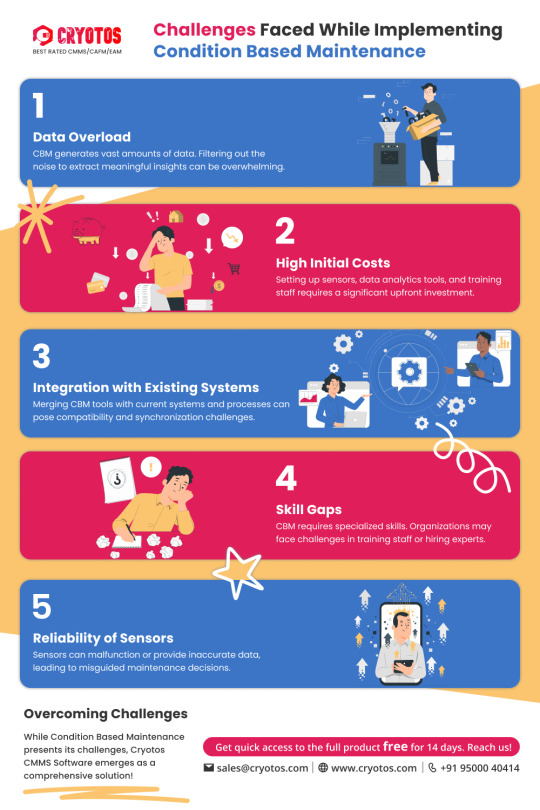
Challenges Faced While Implementing Condition Based Maintenance
Implementing Condition-Based Maintenance (CBM) can be challenging. High initial costs, the vast amounts of data generated, and the need for specialized training pose significant barriers. Integrating CBM data with existing systems can also be complex. Additionally, resistance from teams accustomed to traditional maintenance methods can further complicate the adoption process. Overcoming these challenges requires strategic planning and stakeholder buy-in.
#cmms#cmms software#maintenance management#maintenance software#preventive maintenance#predictive maintenance#facility management software#work order
0 notes
Text
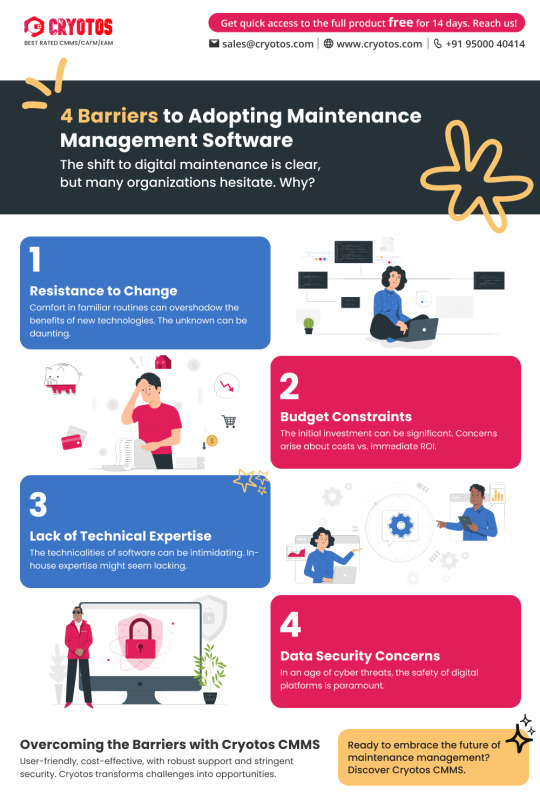
Four Barriers to Adopting Maintenance Management Software
"Adopting Maintenance Management Software offers transformative benefits, yet many organizations hesitate due to four primary barriers: resistance to change, budget constraints, a perceived lack of technical expertise, and concerns about data security. Understanding and addressing these challenges is crucial for a seamless transition to digital maintenance solutions."
#cmms#cmms software#maintenance management#maintenance software#preventive maintenance#predictive maintenance#facility management software#work order
0 notes
Text
Four Barriers to Adopting Maintenance Management Software
#cmms#cmms software#maintenance management#maintenance software#preventive maintenance#facility management software
0 notes
Text
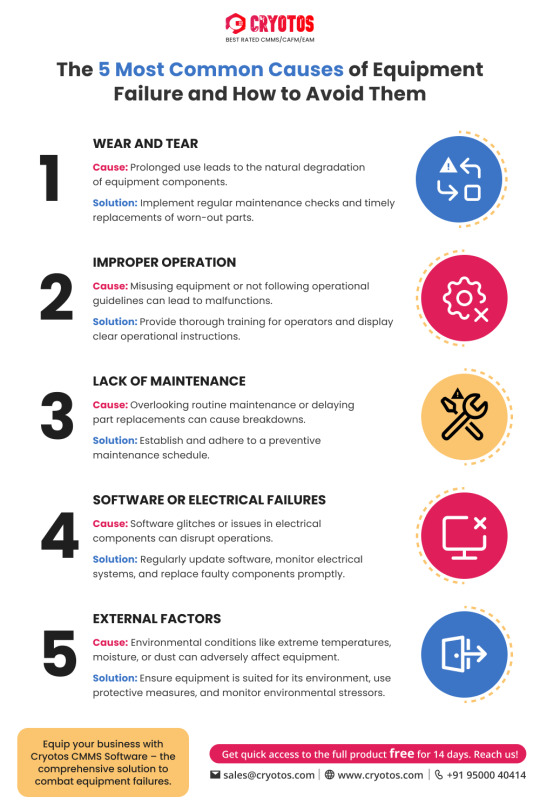
The 5 Most Common Causes of Equipment Failure and How to Avoid Them
Equipment failure is a significant concern for businesses, but it can be mitigated by identifying its root causes and implementing preventive measures. The five most common reasons for equipment failure include a lack of maintenance, overloading or improper use, wear and tear, environmental factors, and manufacturing defects or poor quality. Regular maintenance schedules, proper training, timely component replacements, protective measures in harsh environments, and investing in reputable brands are essential steps to avoid these issues. By proactively addressing these causes, businesses can ensure equipment longevity, reduce downtime, and maintain smooth operations.
#cmms#cmms software#maintenance management#maintenance software#preventive maintenance#predictive maintenance#facility management software#work order
0 notes
Text
The Role of Standard Operating Procedures (SOPs) in Maintenance Management
Standard Operating Procedures (SOPs) are systematic, documented processes or sets of steps that guide routine operations and tasks. In the realm of maintenance management, SOPs play a pivotal role in ensuring that maintenance tasks are performed consistently, efficiently, and safely. They provide a standardized approach to critical procedures, ensuring that all maintenance personnel have clear and concise instructions, reducing variability in task execution. This not only prolongs equipment life and ensures safety but also promotes a predictable and efficient maintenance workflow. SOPs also aid in training new personnel, ensuring that they can quickly adapt to established procedures. In essence, SOPs are fundamental to achieving operational reliability, safety, and efficiency in maintenance management.
#cmms#cmms software#maintenance management#maintenance software#predictive maintenance#preventive maintenance#facility management software#work order
0 notes
Text
This article delves into the differences between Computerized Maintenance Management Systems (CMMS) and Enterprise Asset Management (EAM) software. By exploring their respective functionalities, features, and applications, the reader gains a clear understanding of how these two types of software serve distinct purposes in managing maintenance and assets within an organization. The article aims to decode the unique characteristics of CMMS and EAM, helping businesses make informed decisions in choosing the right solution to optimize their maintenance and asset management processes.
#cmms#cmms software#maintenance management#maintenance software#predictive maintenance#preventive maintenance#facility management software
0 notes
Text

🔧 Boost Efficiency & Reliability with a Proactive Approach! Discover the Step-by-Step Guide on How to Create a Preventive Maintenance Plan in 7 Simple Steps!💡
Are unexpected breakdowns and costly downtime impacting your business operations? Don't wait for equipment failures to disrupt your productivity! Take charge with a well-structured preventive maintenance plan that ensures smooth operations and extends the lifespan of your valuable assets. In this comprehensive guide, we'll walk you through seven straightforward steps to establish an effective preventive maintenance strategy tailored to your specific needs.
#preventive maintenance#predictive maintenance#maintenance software#maintenance management#facility management software#work order#cmms software#cmms
0 notes
Text
Unlock the advantages of Preventive Maintenance Software with easy document sharing. Experience streamlined maintenance processes, reduced downtime, and extended equipment lifespan. Automated scheduling ensures timely inspections, and data-driven insights optimize resource allocation. Enhance productivity and cost-efficiency while fostering proactive maintenance practices for optimal business performance.
0 notes
Text
What is the Difference Between Prescriptive and Predictive Maintenance?
Organizations increasingly adopt advanced maintenance strategies in today's dynamic industrial landscape to optimize equipment performance and minimize downtime. Two such approaches gaining prominence are predictive maintenance and prescriptive maintenance. While they share common goals of improving maintenance effectiveness, they have distinct focuses and methodologies. In this blog post, we will delve into the intricacies of predictive and prescriptive maintenance, exploring their definitions, key differences, benefits, and implementation considerations.

Understanding Predictive Maintenance
Predictive Maintenance (PdM) is a proactive maintenance strategy that leverages data analysis and condition monitoring to predict potential failures before they occur. Organizations can identify patterns, anomalies, and deviations that indicate equipment degradation or potential failure points by collecting real-time data from sensors and analyzing historical trends.
Definition and Explanation of Predictive Maintenance: Predictive maintenance involves monitoring the performance and condition of equipment to detect early warning signs of potential failures. It utilizes advanced analytics, machine learning algorithms, and statistical models to analyze data and generate insights about the health and performance of assets. These insights help maintenance teams decide when maintenance actions should be taken to prevent unplanned downtime.
Key Principles and Objectives of Predictive Maintenance: The primary principle of predictive maintenance is to detect issues and intervene before they cause disruptions or failures. By continuously monitoring equipment performance and collecting data on key parameters such as temperature, vibration, and lubrication levels, organizations can establish baseline conditions and set thresholds for abnormal behavior. Predictive maintenance aims to:
Minimize Unplanned Downtime: By identifying potential failures in advance, organizations can schedule maintenance activities proactively, avoiding unexpected breakdowns and disruptions to operations. This leads to improved productivity, customer satisfaction, and overall operational efficiency.
Optimize Maintenance Schedules: Predictive maintenance enables organizations to optimize maintenance schedules based on equipment's actual condition and health. Instead of relying on fixed time-based maintenance intervals, maintenance actions can be planned and executed when the equipment's performance or condition deviates from the normal range. This maximizes the utilization of maintenance resources and reduces unnecessary maintenance activities.
Improve Resource Allocation: With predictive maintenance, organizations can allocate resources more efficiently by focusing on equipment that requires immediate attention. Maintenance teams can optimize their efforts and address critical issues by prioritizing maintenance actions based on the severity of potential failures or degradation trends. This ensures that resources are utilized where they are most needed, resulting in cost savings and improved maintenance effectiveness.
Benefits and Advantages of Implementing Predictive Maintenance Strategies: Predictive maintenance offers numerous benefits that go beyond traditional maintenance approaches. By proactively identifying and addressing potential failures, organizations can:
Improve Asset Reliability: Predictive maintenance helps organizations achieve higher levels of asset reliability by reducing the risk of unexpected failures. By monitoring equipment performance and condition in real-time, organizations can detect and address issues before they escalate, leading to increased uptime and longevity.
Reduce Maintenance Costs: Organizations can optimize maintenance activities and reduce unnecessary repairs or replacements by identifying maintenance needs based on equipment conditions rather than predetermined schedules. This results in cost savings by avoiding reactive and costly emergency repairs.
Enhance Resource Efficiency: Predictive maintenance enables organizations to allocate their maintenance resources more efficiently. By focusing on equipment requiring immediate attention, maintenance teams can prioritize and plan maintenance activities effectively, resulting in improved resource utilization and reduced downtime.
Enable Data-Driven Decision-Making: With the use of advanced analytics and machine learning, predictive maintenance provides valuable insights into equipment performance trends, patterns, and potential failures. This data-driven approach empowers maintenance teams to make informed decisions and take proactive measures to optimize maintenance strategies.
Organizations can shift from reactive maintenance practices to proactive and data-driven approaches by implementing predictive maintenance strategies. This improves equipment reliability and enhances overall maintenance effectiveness, reduces costs, and drives operational efficiency.
Understanding Prescriptive Maintenance
Prescriptive Maintenance (RxM) goes beyond predictive maintenance by not only predicting potential failures but also providing specific recommendations and actions to mitigate those failures. It leverages advanced analytics, artificial intelligence (AI), and machine learning to analyze data, generate actionable insights, and prescribe optimal maintenance actions.
Definition and Explanation of Prescriptive Maintenance: Prescriptive maintenance takes the insights generated by predictive maintenance by recommending the best course of action to address potential failures. It combines data analysis, AI algorithms, and domain expertise to guide maintenance teams in executing maintenance activities more effectively.
How Prescriptive Maintenance Goes Beyond Predictive Maintenance: While predictive maintenance focuses on identifying potential failures and scheduling maintenance based on data insights, prescriptive maintenance provides specific guidance on how maintenance activities should be performed. It offers actionable recommendations and instructions for maintenance teams to optimize their actions and achieve the best possible outcomes.
Role of Advanced Analytics and AI in Prescriptive Maintenance: Prescriptive maintenance relies on advanced analytics techniques, machine learning algorithms, and AI models to analyze complex data sets and generate actionable insights. Prescriptive maintenance algorithms can determine the most effective maintenance actions, techniques, and sequences for a given situation by considering multiple variables, historical data, and equipment-specific parameters.
Prescriptive maintenance leverages advanced technologies to optimize maintenance strategies and ensure that maintenance activities are performed precisely and efficiently. By incorporating AI-driven recommendations, organizations can take proactive steps to prevent failures, improve equipment performance, and maximize the lifespan of their assets. This data-driven approach enables organizations to optimize maintenance processes and make informed decisions for optimal maintenance outcomes.
Key Differences Between Predictive and Prescriptive Maintenance
Focus and Scope
Predictive maintenance: The primary focus is on identifying potential failures and scheduling maintenance based on data insights. It provides valuable information about the health and performance of equipment, enabling maintenance teams to plan and execute maintenance activities proactively.
Prescriptive maintenance: In addition to predicting failures, prescriptive maintenance recommends specific actions and steps based on data analysis. It provides actionable guidance to maintenance teams, detailing how maintenance activities should be performed for optimal outcomes.
Decision-Making Process
Predictive maintenance: It provides data-driven insights to help determine when maintenance actions should be taken, allowing maintenance teams to plan and schedule maintenance proactively. Decision-making involves analyzing data patterns, identifying trends, and setting maintenance priorities.
Prescriptive maintenance: By leveraging advanced analytics and AI, prescriptive maintenance guides decisions on executing maintenance activities. It utilizes historical data, real-time monitoring, and predictive models to prescribe specific actions, steps, and sequences to achieve the desired maintenance outcomes.
Level of Automation
Predictive maintenance: It provides information and insights to maintenance teams, who then make decisions and take appropriate actions based on the analysis. While automation can be involved in data collection and analysis, the ultimate decision-making and action implementation lies with human operators.
Prescriptive maintenance: Automation plays a significant role in prescriptive maintenance. It integrates advanced technologies like AI and machine learning to analyze data, generate recommendations, and execute maintenance actions autonomously. Prescriptive maintenance streamlines maintenance workflows reduces human error, and enhances efficiency by leveraging automation.
Integration of Advanced Technologies
Predictive maintenance: It relies on data analytics, machine learning, and statistical models to predict potential failures based on historical and real-time data. Predictive maintenance helps identify equipment degradation and potential failure points by detecting anomalies and deviations.
Prescriptive maintenance: Building upon predictive maintenance, prescriptive maintenance integrates advanced technologies like AI, machine learning, and expert systems. It employs sophisticated algorithms and models to generate actionable recommendations and optimize maintenance strategies. Prescriptive maintenance supports decision-making, process automation, and continuous improvement by leveraging AI-driven insights.
Benefits and Applications of Predictive and Prescriptive Maintenance
Predictive Maintenance
Minimizing unplanned downtime: Organizations can proactively schedule maintenance activities by identifying potential failures in advance, reducing unplanned downtime. This leads to improved productivity, customer satisfaction, and overall operational efficiency.
Reducing maintenance costs: Predictive maintenance optimizes maintenance schedules, prevents unnecessary repairs, and maximizes utilizing maintenance resources. It helps organizations achieve cost savings by avoiding reactive and costly emergency repairs.
Prescriptive Maintenance
Providing actionable recommendations: Prescriptive maintenance takes maintenance guidance to a new level by providing specific instructions and recommendations for maintenance activities. It offers insights into the most effective techniques, processes, and resources to execute maintenance tasks successfully.
Enhancing equipment reliability and performance: By prescribing optimal maintenance actions, prescriptive maintenance ensures that maintenance tasks are performed optimally. It helps enhance equipment reliability, reduce the risk of unexpected failures, and maximize overall performance.
Considerations for Implementation
Data Collection and Analysis Requirements
Identifying relevant data sources: Organizations should determine the key parameters and variables to monitor based on equipment criticality and failure patterns. This may involve integrating IoT sensors, data loggers, and other monitoring devices.
Ensuring data quality and accuracy: Data integrity is crucial for reliable predictive and prescriptive maintenance. Organizations need to establish data validation processes, address data gaps, and ensure data consistency across systems.
Technology and Infrastructure Considerations
Assessing the existing technology infrastructure: Organizations should evaluate the compatibility of their existing systems with predictive and prescriptive maintenance solutions. This may involve selecting suitable data analytics platforms, integrating IoT devices, and establishing connectivity protocols.
Determining resource requirements: Implementing predictive and prescriptive maintenance may require additional hardware, software, and human resources. Adequate budgeting, resource allocation, and capacity planning are essential for successful implementation.
Change Management and Training Needs
Addressing cultural and organizational challenges: Implementing predictive and prescriptive maintenance requires a cultural shift towards data-driven decision-making, collaboration between maintenance and other departments, and embracing new technologies.
Providing training and upskilling: Maintenance teams need to acquire the necessary skills and knowledge to operate and interpret the outputs of predictive and prescriptive maintenance systems effectively. Training programs, workshops, and knowledge-sharing initiatives can bridge any skills gaps.
Conclusion
In summary, predictive and prescriptive maintenance are two powerful strategies that enable organizations to optimize maintenance efforts and improve equipment reliability. While predictive maintenance focuses on predicting potential failures based on data insights, prescriptive maintenance goes a step further by recommending specific actions to mitigate those failures. By leveraging advanced analytics, AI, and machine learning, organizations can transition from reactive maintenance to proactive strategies, minimizing downtime, reducing costs, and maximizing asset performance.
By understanding the distinctions between predictive and prescriptive maintenance and considering the unique requirements of their operations, organizations can make informed decisions and implement the most suitable maintenance approach for their specific needs. The future of Maintenance Management lies in embracing these advanced strategies, harnessing data-driven insights, and continuously improving maintenance processes to achieve operational excellence.
#cmms#cmms software#maintenance software#maintenance management#predictive maintenance#preventive maintenance#prescriptive maintenance
0 notes
Text
When to Use Breakdown Maintenance?
"Breakdown maintenance, also known as reactive maintenance, refers to the strategy of repairing equipment and machinery only after it has broken down or malfunctioned. This approach is most suitable for non-critical assets where downtime doesn't significantly impact operations or costs. While it can be cost-effective in the short term, relying solely on breakdown maintenance can lead to higher long-term repair costs, increased downtime, and potential operational disruptions. It's essential to weigh the pros and cons of this maintenance strategy based on the criticality of the equipment and the overall operational requirements."
#cmms#cmms software#maintenance management#maintenance software#preventive maintenance#facility management software#predictive maintenance#work order
0 notes